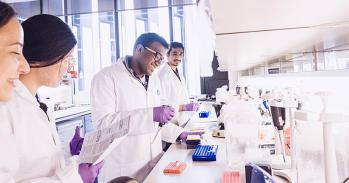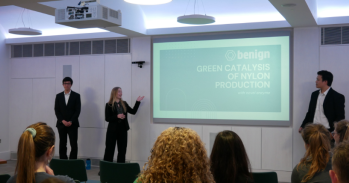
When you’re under attack, you fight back. You gather your troops and attack the invading enemy, hoping to wound and defeat them, while supporting and treating your own injured soldiers. It’s common sense.
When you’re under attack, you fight back. You gather your troops and attack the invading enemy, hoping to wound and defeat them, while supporting and treating your own injured soldiers. It’s common sense.
The hardest thing for me was getting people to buy into the idea... why would you want to inhibit DNA repair?
Steve Jackson
If you’re based at the Wellcome Trust/Cancer Research UK Gurdon Institute, however, the common sense approach is not necessarily the road most travelled – and for good reason. The word ‘counterintuitive’ is one you will hear surprisingly often when you talk to its researchers about their work.
No one illustrates this better than Professor Steve Jackson, who has been at the Institute since it opened 25 years ago and made his name – and a new class of cancer drug – from a seemingly counterintuitive approach to cancer: to switch off a mechanism that is meant to repair our DNA and prevent it mutating, akin to taking out your army medics.
Jackson, like all of the researchers at the Gurdon, is a basic scientist – in other words, his work looks at the fundamental biology that underpins how our bodies work. Basic science is rarely fashionable, rarely flashy, but without it we would have few of the medicines we take for granted today.
However, this process also takes time: Lynparza, the medicine that resulted from Jackson’s work, was granted Marketing Authorisation from the European Commission and the US Food and Drug Administration in 2014, more than two decades after he began researching this area; the drug is now available in over 40 countries worldwide.
In fact, as with a surprising amount of science, his breakthrough moment was the result of a chance observation. He co-discovered an enzyme that was activated by DNA, and then observed that it was actually activated by breaks in DNA. Most DNA used in labs is circular, but Jackson was using ‘strings’ of DNA, which have ends
“If I’d been using circular DNA, I’d have never seen this effect and I never would have developed my career in this direction, but this discovery made me think ‘Wow, maybe because this enzyme is activated by breaks, it must be involved in DNA repair’. When you’re working in basic science and you follow your nose, you can spot things and hopefully recognise what they’re telling you – and in my case, it was saying ‘Maybe you want to work on DNA repair’.”
It was a second DNA repair enzyme – known as PARP – that was to lead to the development of olaparib (marketed as Lynparza) and to Jackson setting up his own company, KuDOS, as he saw its potential as a drug target. KuDOS was eventually bought out by AstraZeneca, the pharmaceutical giant that will soon move its headquarters to Cambridge.
DNA repair is so important to our survival that we have evolved a backup mechanism in case PARP fails, known as homologous recombination, in which DNA is exchanged between identical pieces of DNA to repair it. In some cancer cells – most notably those associated with mutations in the BRCA1 or BRCA2 genes – this mechanism fails. Tumour cells in individuals with these genes carry two ‘bad’ copies of the gene, which inactivates homologous recombination, but the individual’s healthy cells carry one good copy, meaning that they can still carry out this process.
“This was a ‘Eureka’ moment,” says Jackson. “We realised that if you block the PARP repair mechanism in these individuals, the healthy cells revert to their backup and survive, but the tumour cells have no backup and so will die.”
Just under one in three cases of ovarian cancer is caused by the BRCA genes, and it is for these individuals that Lynparza has been licensed. Recent studies suggest that around the same proportion of prostate cancer cases may be linked to BRCA gene mutations, and to one in ten cases of breast cancer; if Lynparza is approved for all of these patients, it could make a huge difference to survival rates. The drug isn’t perfect – it doesn’t work in all BRCA patients and some patients develop resistance to the drug – but it is clearly extending and enhancing many lives.
“We all hope to cure cancer, and PARP inhibitors are curing a small proportion of patients,” says Jackson, “but what we’re doing is moving cancer towards becoming a long-term disease that is kept in check through different phases. That’s a good business model for pharmaceutical companies, ensuring that they invest in this area, but most of all, it’s good for the patients.”
Jackson jokes that he had much more hair when he started out – running his own company alongside his work, and trying to get others to support his approach “nearly did me in,” he laughs. “The hardest thing for me was getting people to buy into the idea as it was counterintuitive: why would you want to inhibit DNA repair? DNA repair’s good – that’s what the pharma companies said, that’s what the venture capitalists initially said.”
Just as Jackson’s work eschews the common sense approach, so too does the work of his colleague Dr Eugenia Piddini. If switching off cells’ repair mechanisms sounds counterintuitive, then so does the idea of stopping the mechanism that is intended to cause diseased cells to fall on their swords – programmed cell death, or ‘apoptosis’.
Like many of the scientists at the Gurdon, Piddini mostly works on much simpler organisms than humans. In addition to studying human cells, Jackson also works on yeast, while Piddini complements her mammalian studies with work on the fruit fly. We may not have shared a common ancestor for hundreds of millions of years – a billion, even – but we still share many of the fundamental processes that take place in our bodies.
At the last count, since its launch in 1991, the Gurdon has created 200 group leaders around the world. That’s quite an army of scientists fighting counterintuitive battles.
Piddini looks at the competition that takes place between cells, and in particular how cells talk to each other and how this enables the tissue to select the strongest cells. “It’s a kind of quality control,” she explains. “But it’s been suggested for some time that cancer cells somehow disguise themselves, making them look stronger so they can kill off their neighbours and colonise their space.”
She believes this may help explain why, as cancers spread throughout the body – or ‘metastasise’ – they cause organ failure. “There will come a point where there are no longer enough healthy cells for the organ to continue to function.”
Many existing chemotherapy drugs encourage apoptosis. Not only does this cause collateral damage to healthy cells – which is why chemotherapy patients get so sick – but, says Piddini, apoptosis is exactly the process that cancer cells are using against healthy cells. So once again, this leads to a seemingly counterintuitive solution: stop cell death.
“If you can somehow inhibit apoptosis, then you can keep the healthy cells alive. And if you keep the healthy cells alive, you stop the cancer cells spreading and the tumour should die away.”
This is still very early stage research: to some extent, Piddini is where Jackson was not long after he first joined the Gurdon, but as for PARP inhibitors, she believes her approach shows a great deal of promise. “I hope that one day we’ll talk about this in the same way we talk about Steve’s work now,” she says enthusiastically.
Piddini – talked of as one of the rising stars in her field – will be leaving Cambridge next summer for the University of Bristol. Jackson believes her move further emphasises the strengths of the Gurdon Institute.
“You can tell a successful research environment by its alumni,” he says, “by looking at who has trained there and has moved on to lead a group elsewhere.” At the last count, since its launch in 1991, the Gurdon has created 200 group leaders around the world. That’s quite an army of scientists fighting counterintuitive battles.

The text in this work is licensed under a Creative Commons Attribution 4.0 International License. For image use please see separate credits above.




